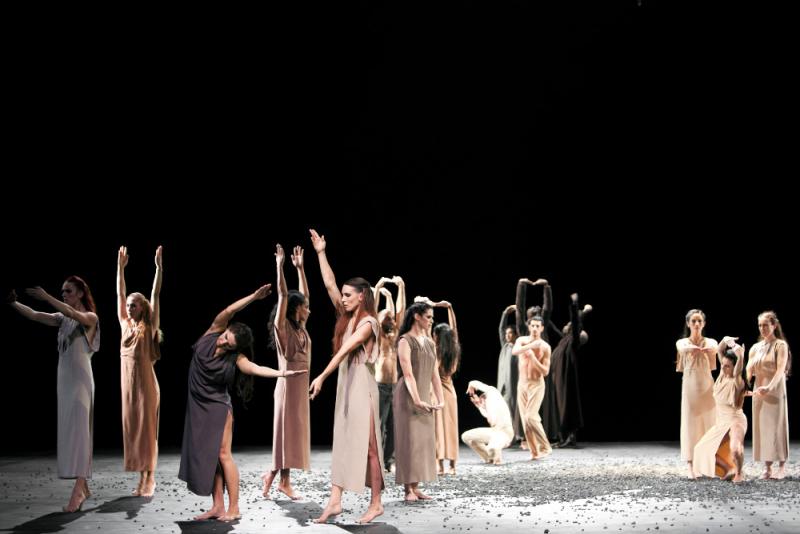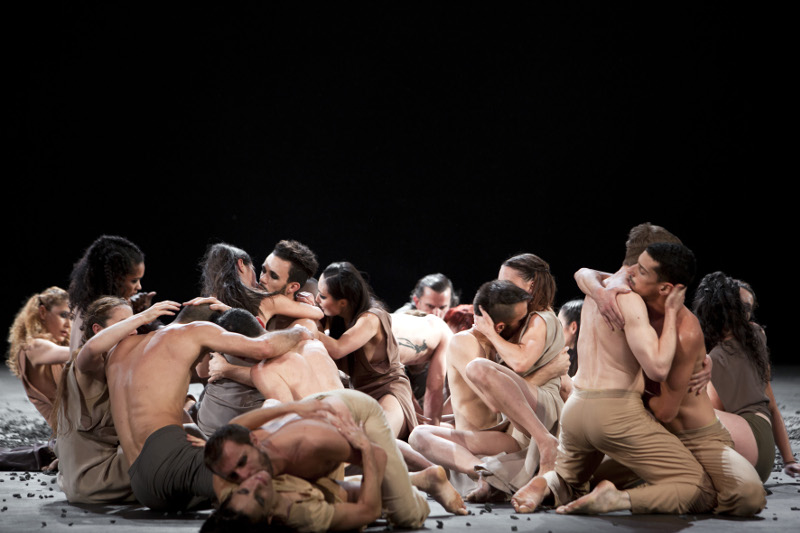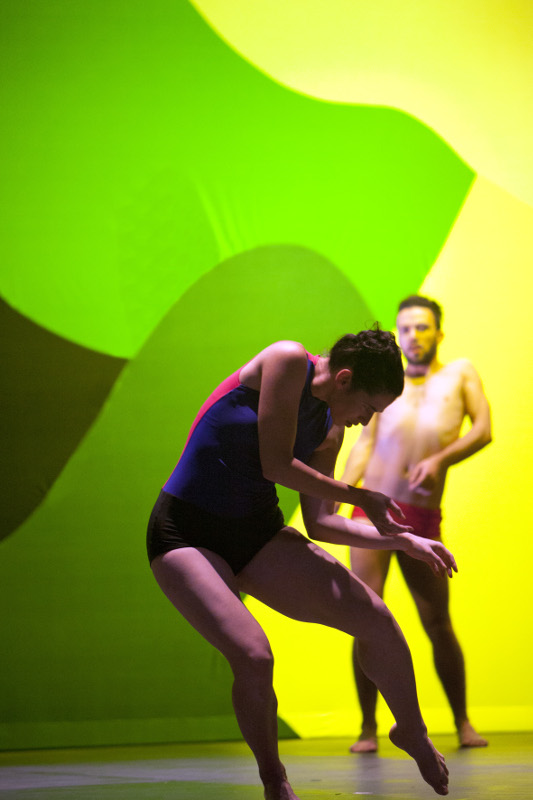Sacre, Sasha Waltz and Guests, Sadler's Wells | reviews, news & interviews
Sacre, Sasha Waltz and Guests, Sadler's Wells
Sacre, Sasha Waltz and Guests, Sadler's Wells
German choreographer delivers a Rite of Spring to remember

What dancemaker wouldn't want to tackle Le Sacre du Printemps (The Rite of Spring) at some point? Just as the Stravinsky score changed music, the original Ballets Russes production changed dance - and was then, conveniently, so completely forgotten that no master-text exists. Everyone is free to take the Stravinsky and run.
Yet Sasha Waltz, one of Germany's foremost contemporary dancemakers, was at first reluctant to create her own Sacre, though she eventually did it – and for no less illustrious an ensemble and occasion than a Mariinsky Ballet performance in Paris 100 years to the day after the original's legendarily shocking première in May 1913. In Paris, Waltz's creation was shown – at her own request – alongside a 1987 reconstruction of the original, which is generally agreed to be an arid museum piece, but which Waltz says is what inspired her to take the commission. For last night's UK première at Sadler's Wells we had only her own version, preceded by two little morsels from the Waltz back catalogue, L'après-midi d'un faune (2013) and a 'Scène d'Amour' from her Berlioz-scored Romeo and Juliet (2007)
Fortunately, where Waltz's Sacre is being performed, there is absolutely no need to see any speculative, academic reconstruction: her piece is a magisterial response to the music (here, sadly, only a recording) and the evergreen, unsettling power of the scenario, and it is in its own way extremely faithful to the spirit of the Ballets Russes production. That famously engendered conflict between the choreographer Nijinsky and his classically-trained dancers over movement style, with Nijinsky spending hours refining a certain kind of walk, or shuffle, that for him was how an imagined primitive community would move, but that for ballet dancers felt like a vicious inversion of the disicpline's endless striving after refinement and elevation.
As a German choreographer of contemporary dance, Waltz is the inheritor of that campaign for naturalness and against refinement in whose annals Nijinsky's Sacre makes a distinguished appearance alongside modern dance pioneers Rudolf von Laban and Isadora Duncan, and often the choreography in her Sacre follows closely the descriptions we have of the original. Romola Nijinsky's words, "the dancers shiver, tremble and vibrate" and "shifting masses...are ceaselessly splitting up into tiny groups revolving on eccentric axles", precisely describe segments of Waltz's Sacre.

Waltz's movement language is firmly based on the naturalistic flat foot, which is made a feature in Sacre through stamping, running and walking. More generally she aims for the kind of naturalism that almost masks its origins in an organising mind: formations are loose and constantly shifting, interactions physical but far from merely danced (there is biting, kissing, wrestling, simulated sex - pictured above), and nobody seems to be dancing to a script - though of course they are, and the artistry required to look so effortless is revealed when a couple of children appear on stage later, their artlessness a noticeable contrast to the studied ease of the adult dancers. The rite itself unfolds with seeming spontaneity: it's not clear for a long time if it is driving towards the traditional sacrifice, or if so, who the victim will be. This uncertainty generates a brilliantly pervasive apprehension, so that with each flare-up of conflict, each act of division or violence, we ask ourselves, "is it coming now? Is this it?"
It is in keeping with this powerful, palpable atmosphere that Waltz expands the stage to its fullest possible extent: with wings and back curtains removed, the performance space goes beyond what the proscenium allows us to see, and its boundaries are literally blurred by the pale floating dust that hangs over everything. Also hanging over everything - though this only gradually becomes apparent - is a huge metal spike, a needle-shaped Damoclean sword which descends in infinitesimal increments, reaching the floor with brilliant finality precisely at the moment of the Chosen One's final collapse.  Waltz's Faune showcases the same naturalism, the same unsettling unpredictability as Sacre, and also shares the latter's historical sympathies, using a Matisse-like painted backcloth (pictured left) and and overtly sexual moves that both recall in atmosphere, if not in specifics, the Bakst designs and onanistic ending of the original 1912 Ballets Russes Faune. The 'Scene d'Amour' is the more likeable of the two, an easy flow of exploratory and tender interactions which resembles a balletic pas de deux in structure but again uses a more modern movement language, and seems to involve a delightfully grown-up and confident Romeo and Juliet.
Waltz's Faune showcases the same naturalism, the same unsettling unpredictability as Sacre, and also shares the latter's historical sympathies, using a Matisse-like painted backcloth (pictured left) and and overtly sexual moves that both recall in atmosphere, if not in specifics, the Bakst designs and onanistic ending of the original 1912 Ballets Russes Faune. The 'Scene d'Amour' is the more likeable of the two, an easy flow of exploratory and tender interactions which resembles a balletic pas de deux in structure but again uses a more modern movement language, and seems to involve a delightfully grown-up and confident Romeo and Juliet.
To be honest, the other two pieces are rather left in the dust by Sacre's epic scale and immersive atmosphere, but they are good companion pieces for it, and a bonus given that Sacre on its own is eminently worth seeing. It's a Rite of Spring to rank along with the best, and packs more power in its 40 minutes than many an evening I've seen at three times the length.
- Sasha Waltz and Guests perform this programme at Sadler's Wells tonight and tomorrow (12-13 November).
rating
Explore topics
Share this article
Add comment
The future of Arts Journalism
You can stop theartsdesk.com closing!
We urgently need financing to survive. Our fundraising drive has thus far raised £49,000 but we need to reach £100,000 or we will be forced to close. Please contribute here: https://gofund.me/c3f6033d
And if you can forward this information to anyone who might assist, we’d be grateful.

Subscribe to theartsdesk.com
Thank you for continuing to read our work on theartsdesk.com. For unlimited access to every article in its entirety, including our archive of more than 15,000 pieces, we're asking for £5 per month or £40 per year. We feel it's a very good deal, and hope you do too.
To take a subscription now simply click here.
And if you're looking for that extra gift for a friend or family member, why not treat them to a theartsdesk.com gift subscription?
more Dance
 'We are bowled over!' Thank you for your messages of love and support
Much-appreciated words of commendation from readers and the cultural community
'We are bowled over!' Thank you for your messages of love and support
Much-appreciated words of commendation from readers and the cultural community
 Like Water for Chocolate, Royal Ballet review - splendid dancing and sets, but there's too much plot
Christopher Wheeldon's version looks great but is too muddling to connect with fully
Like Water for Chocolate, Royal Ballet review - splendid dancing and sets, but there's too much plot
Christopher Wheeldon's version looks great but is too muddling to connect with fully
 iD-Reloaded, Cirque Éloize, Marlowe Theatre, Canterbury review - attitude, energy and invention
A riotous blend of urban dance music, hip hop and contemporary circus
iD-Reloaded, Cirque Éloize, Marlowe Theatre, Canterbury review - attitude, energy and invention
A riotous blend of urban dance music, hip hop and contemporary circus
 How to be a Dancer in 72,000 Easy Lessons, Teaċ Daṁsa review - a riveting account of a life in dance
Michael Keegan-Dolan's unique hybrid of physical theatre and comic monologue
How to be a Dancer in 72,000 Easy Lessons, Teaċ Daṁsa review - a riveting account of a life in dance
Michael Keegan-Dolan's unique hybrid of physical theatre and comic monologue
 A Single Man, Linbury Theatre review - an anatomy of melancholy, with breaks in the clouds
Ed Watson and Jonathan Goddard are extraordinary in Jonathan Watkins' dance theatre adaptation of Isherwood's novel
A Single Man, Linbury Theatre review - an anatomy of melancholy, with breaks in the clouds
Ed Watson and Jonathan Goddard are extraordinary in Jonathan Watkins' dance theatre adaptation of Isherwood's novel
 Peaky Blinders: The Redemption of Thomas Shelby, Rambert, Sadler's Wells review - exciting dancing, if you can see it
Six TV series reduced to 100 minutes' dance time doesn't quite compute
Peaky Blinders: The Redemption of Thomas Shelby, Rambert, Sadler's Wells review - exciting dancing, if you can see it
Six TV series reduced to 100 minutes' dance time doesn't quite compute
 Giselle, National Ballet of Japan review - return of a classic, refreshed and impeccably danced
First visit by Miyako Yoshida's company leaves you wanting more
Giselle, National Ballet of Japan review - return of a classic, refreshed and impeccably danced
First visit by Miyako Yoshida's company leaves you wanting more
 Quadrophenia, Sadler's Wells review - missed opportunity to give new stage life to a Who classic
The brilliant cast need a tighter score and a stronger narrative
Quadrophenia, Sadler's Wells review - missed opportunity to give new stage life to a Who classic
The brilliant cast need a tighter score and a stronger narrative
 The Midnight Bell, Sadler's Wells review - a first reprise for one of Matthew Bourne's most compelling shows to date
The after-hours lives of the sad and lonely are drawn with compassion, originality and skill
The Midnight Bell, Sadler's Wells review - a first reprise for one of Matthew Bourne's most compelling shows to date
The after-hours lives of the sad and lonely are drawn with compassion, originality and skill
 Ballet to Broadway: Wheeldon Works, Royal Ballet review - the impressive range and reach of Christopher Wheeldon's craft
The title says it: as dancemaker, as creative magnet, the man clearly works his socks off
Ballet to Broadway: Wheeldon Works, Royal Ballet review - the impressive range and reach of Christopher Wheeldon's craft
The title says it: as dancemaker, as creative magnet, the man clearly works his socks off
 The Forsythe Programme, English National Ballet review - brains, beauty and bravura
Once again the veteran choreographer and maverick William Forsythe raises ENB's game
The Forsythe Programme, English National Ballet review - brains, beauty and bravura
Once again the veteran choreographer and maverick William Forsythe raises ENB's game
 Sad Book, Hackney Empire review - What we feel, what we show, and the many ways we deal with sadness
A book about navigating grief feeds into unusual and compelling dance theatre
Sad Book, Hackney Empire review - What we feel, what we show, and the many ways we deal with sadness
A book about navigating grief feeds into unusual and compelling dance theatre

Comments
Also must have been a